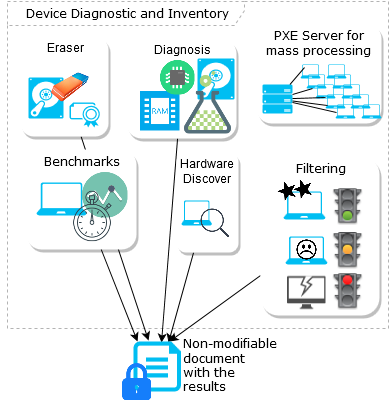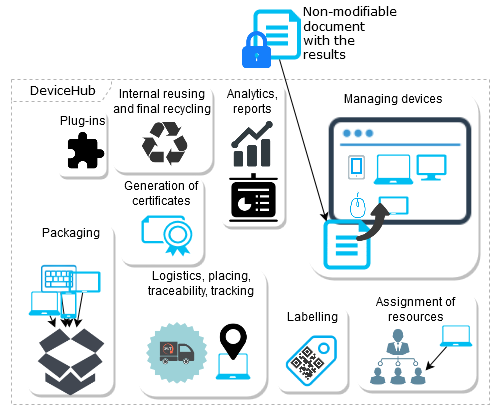Launched in 2015, the eReuse.org initiative has worked for a decade promoting best practices for computer refurbishment through the digitalization of the processes, working with organizations across the globe. To implement these practices and standards, eReuse.org proposes an open-source stack for ITADs, refurbishers, and recyclers.
- Workbench creates a hardware snapshot of the device and its components, including device identifiers.
- Workbench evidence reports are sent or uploaded to Devicehub. Devicehub is a device inventory service, also known as an IT Asset Management System (ITAMS), focused on maximizing device lifetime through reuse. It runs as a web service for organizations to manage, track, and exchange devices.
- The Global Registry of Devices (GRD) receives optional non-private metadata about devices from ITAMS, such as Devicehub instances. It is an auditable (and replicable) semi-public online registry that maintains a global list of privacy-preserving information about devices as a semi-public third-party registry for transparency and accountability.
In the following sections, we detail the two main software elements.
Workbench

The Workbench is a toolset that assists in registering, refurbishing, and tracking devices. It captures hardware characteristics (like the serial number) of devices and their components, rates the devices and securely deletes data. With its self-booting start-up, you don’t have to worry about which operating system is installed. Just boot your device through the network with the PXE Server and test and benchmark your system hardware, capture characteristics for rating and the serial number for traceability and reporting. It processes detailed hardware information at the component level. This result is then uploaded to the distributed cloud software; the Devicehub, which we explain next.
The software executes on a computer and, without human interaction, automatically executes the following tools:
- Hardware discovery. Obtains metadata from the computer and its components, including ways of identifying a device and information for traceability, reusing, and generating circularity inputs.
- Data erasure. Delete private information from data storage units by performing standardized erasure methods that users can parametrize (requires integration with other tools).
- Benchmarking. Rates the capacity of the computer and its components in order to value them.
- Testing. Performs quality tests to guarantee the capacity of the machine to operate correctly and without failure.
See Workbench Computer in Github
DeviceHub
 An inventory service or Device Asset Management System, offered as a web app and focused on efficiently managing the circular life-cycle of devices for reuse and recycling. The main objectives are:
An inventory service or Device Asset Management System, offered as a web app and focused on efficiently managing the circular life-cycle of devices for reuse and recycling. The main objectives are:
- To offer a common IT Asset Management system for donors, receivers, and IT professionals so they can manage devices and exchange them. This is reusing—and ultimately recycling.
- To automatically collect, analyse, process, and share (controlling privacy) metadata about devices with other tools of the eReuse ecosystem to guarantee traceability and provide inputs for the indicators that measure circularity.
DeviceHub collects device information from the evidence submitted by Workbench, a form, or a spreadsheet, and manages them across their lifespan. Devicehub manages and prints certificates and customer-friendly reports, manages device lots, and can generate QR data carriers that boost efficiency and avoid device leakage. The main characteristics of Devicehub are:
- Device management: Devicehub manages the asset identification process and the life span of an organization’s devices, the workflow, and external ones over which the organization controls.
- Reports: This feature generates automatic personalized reports and analytics, ensuring compliance and detecting critical aspects, such as device loss, device and ID duplication, etc.
- Certifications: Saves, manages, and exports certificates, such as the test results and hard drive deletions, to answer audits and show them to end users.
- Logistics: manages the allocation of devices as lots to exchange them with third parties.

The Global Registry of Devices (GRD) (Experimental, under development)
The Global Registry of Devices (GRD) is an auditable online log that maintains a global list of traceability information about devices, so it can assist when there is a need to prove an action or produce third-party verifiable reports. It is implemented with distributed ledger technology (private Ethereum). GRD provides a REST API to allow ITAMS, such as DeviceHub instances, to report the life cycle of devices, environmental responsibilities for organizations, etc.
Legacy
Workbench Android App
A smartphone and tablet Android app that has two functionalities.
- Obtain metadata from devices that are not computers, like peripherals or electrical appliances, by scanning their barcodes and taking pictures from them.
- Link devices with tags generated by the tools, like QR codes and NFC chips.
Download Workbench Android App
Photobox
A machine that assists in rating the appearance of a device by taking pictures from devices from different views, like frontal, sides and rear. A developing AI can detect scratches and imperfections from the pictures and automatically rate the devices.